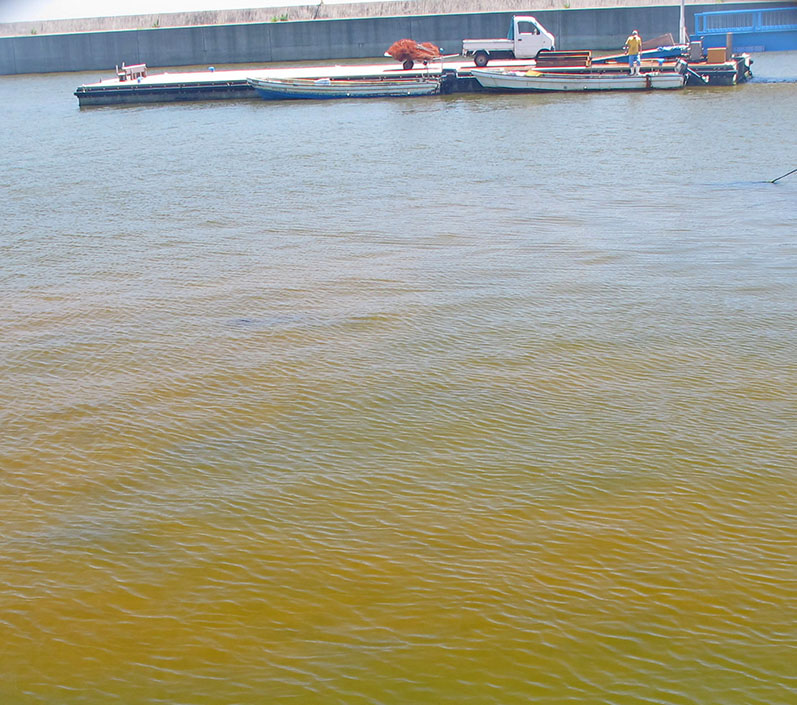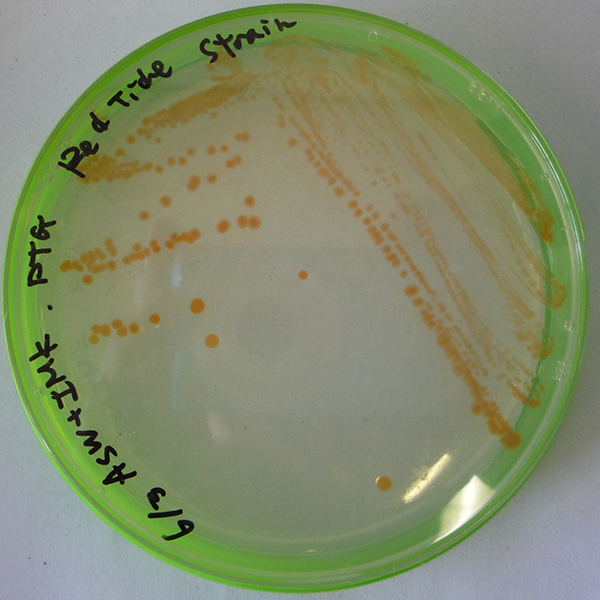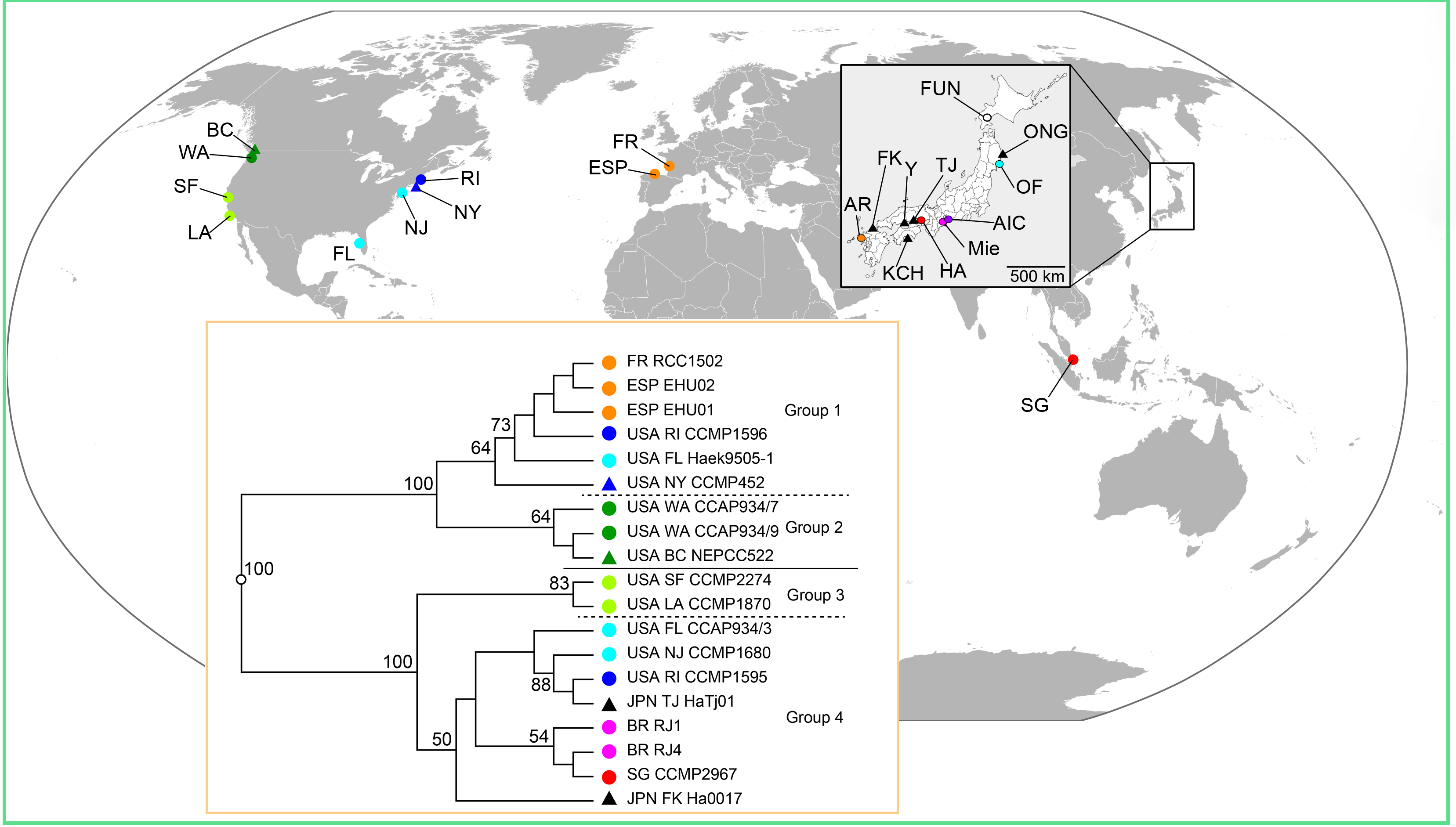


We aim to understand the ecophysology of a bloom-forming alga, Heterosigma akashiwo

Heterosigma often forms bloom during spring ~ summer, when the water temperature rises and light strength intensifies. Occasionally, the densities of bloom reach ~ million cells per milliliter of the seawater, while usually only several cells are found in the same volume of the water in the same area. An extremely high density of Heterosigma can be observed as the obvious water discoloration as in the left picture and may result in massive fish kills and give major economical and ecological damages.
When observing the bloom sample under a microscope, you will notice that most of the species found in the sample are Heterosigma akashiwo. It means that the alga predominates the phytoplankton population in the area, presumably by its fast growth rate. In addition, it has been revealed that H. akashiwo z produces substance(s) that inhibits other species.
Heterosigma has been regarded as a species from the temperate climate zone. However, studies during the past decade or so revealed that the species are found a wide range of climate zones, ranging from tropic to subarctic. While this suggests that the species is highly adaptive to the different environments. It also raises an interesting question, where the species originated and how it has dispersed to the wide-area as observed today.
Currently, we are particularly interested in the four topics shown below.
H. akashiwo transcriptome assembly, gene prediction, and annotation
H. akashiwo possesses 2-Gbp genome, which is compareble to the size of human genome. The sequence of H. akashiwo genome has not been completed yet. We recently completed transcriptome asesmbly, gene prediction and annotation of H. akashiwo. This is the only H. akashiwo transcriptome with functional infereces published to date, and we expect that it will be of great use for the reseachers all over the world. This work has been supported by the Platform for Advanced Genome Science and was carried out as a collaboration with Dr Masanao Sato in Hokkaido University.
Symbiotic interactions between H. akashiwo and marine bacteria

Heterosigma bloom formation is regarded to be triggered by environmental changes, such as eutrophication or water temperature raise. Are there other factors that may promote H. akashiwo bloom? We previously found a marine bacterium, Altererythrobacter ishigakiensis promoted the growth of the alga. Interestingly, the bacterium did not affect the growth rate of another raphidophyte, Chattonella sp., suggesting that the growth promotion by the bacterium was species-specific. Besides, when this bacterium was added to the mixed culture of Heterosigma and Chattonella, the growth of the former was promoted by the bacteria whereas the latter growth was suppressed. This may suggest that the specific growth promotion of H. akashiwo by the bacteria promote the allopathic effect of the alga on Chattonella, allowing the intensified predomination of the former species.
In addition to A. erythrobacter, we found several marine bacteria that promoted the growth of H. akashiwo under different conditions, and are trying to characterize the mechanism of the growth enhancements. To understand whether such symbiotic interactions between bacteria and alga are crucially involved in bloom formation, monitoring of environmental microbes that associate with bloom-forming algae and bloom is the key. We participate in a program to monitor the change of microbiome associate with harmful algal blooms in Chile.
Search for phylogepgraphic markers for H. akashiwo

Heterosigma was regarded as a temperate species that distribute the thalassic sea all over the world. However, studies during the last ten years or so revealed that the species were also found from the tropic area, such as Singapore, Rio de Janeiro, Brazil, and subarctic area, such as Svolvaer, Norway. Is it because we are now conducting detailed monitoring in regions that were previously not covered, or does the species spread to wider geographic zones, possibly due to climate change or anthropologic activities?
We obtained more than 20 strains of H. akashiwo and compared the sequences of their mitochondrial genomes. As a result, we found a hypervariable region on the mitogenome of H. akashiwo, which is closely associated with their geographic origins. Such regions can be utilized as phylogeographic markers to understand the historical process of the geographic dispersion of the species.
Collaboration:Genetic modification of H. akashiwo
Besides the lack of genetic/genomic information, the lack of established procedures for genetic modification is the major impedance to understand H. akashiwo physiology. Our group collaborates with a group in the Department of Engineering, Okayama University, to establish a transient genetic transformation procedure of the species. Once it is established, it will be a breakthrough to decipher the ecophysiology of the species from molecular point-of-view.
Interested in Tackling the Mistery of Red Tide?
To contact or visit the group、click Here
To know more about IPSR Okayama University
To find it out on YouTube, click Here
For more information, click Here